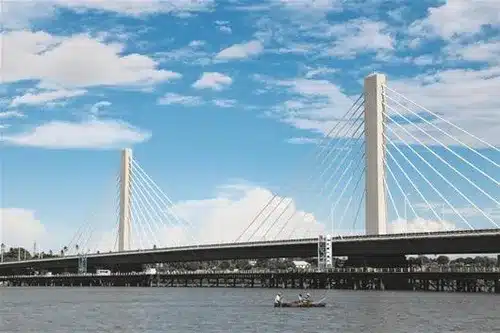Tanzania is on the verge of a major infrastructure milestone with the upcoming launch of the John Magufuli Bridge, also known as the Kigongo–Busisi Bridge. Set to open on June 19, 2025, this 3.2-kilometer-long structure will become the longest bridge in East Africa, playing a pivotal role in connecting the Mwanza and Geita regions. More than just a physical link, this bridge symbolizes national progress, regional trade integration, and a future-oriented vision for East Africa.
Project Summary
-
Official Name: John Pombe Magufuli Bridge
-
Location: Spanning Lake Victoria between Kigongo (Mwanza) and Busisi (Geita)
-
Total Length: 3.2 km (approx. 2 miles)
-
Road Width: 28.45 meters
-
Bridge Type: Extra-dosed bridge with cable-stayed sections
-
Construction Began: December 2019
-
Expected Opening: June 19, 2025
-
Cost Estimate: TZS 716 billion (~USD 270 million)
-
Main Contractors: China Civil Engineering Construction Corporation (CCECC) and China Railway 15th Bureau Group
-
Funding: Fully financed by the Government of Tanzania
Why the Kigongo–Busisi Bridge Matters
For decades, residents and travelers in this part of Tanzania relied on ferry services to cross the Mwanza Gulf of Lake Victoria. These ferries often caused delays, and limited capacity restricted the efficient movement of both goods and people.
The new bridge will cut travel time across the gulf from three hours to under five minutes, improving logistics and safety for daily commuters, businesses, and regional transporters.
It also forms part of the Trunk Road T4, a vital transport corridor that links Tanzania with Uganda, Rwanda, and the Democratic Republic of Congo—making it a strategic asset not just for the country but for the broader East African Community.
Economic and Social Impact
The bridge is expected to:
-
Stimulate cross-border trade by reducing transportation costs
-
Promote investment in Mwanza, Geita, and surrounding regions
-
Boost agriculture and mining sectors through improved logistics
-
Create new opportunities for tourism in Lake Victoria’s ecosystem
-
Contribute to Tanzania’s Vision 2025 agenda of becoming a middle-income economy
Over 1,500 workers—mostly Tanzanians—were involved during the bridge’s construction phase, adding a skills-transfer dimension to the project.
Engineering and Technical Achievements
The Kigongo–Busisi Bridge showcases advanced engineering. It uses a box girder design reinforced with cables, allowing it to withstand heavy traffic loads and natural stressors over water.
Its modern construction standards mean the bridge is built to last over a century with proper maintenance, reducing future infrastructure costs for the nation.
Additional roadworks were completed to connect the bridge with the existing highway network, ensuring seamless integration with national and regional roads.
Legacy of President John Magufuli
The bridge was named after the late President John Pombe Magufuli, who championed domestic infrastructure development during his tenure. The project’s completion under government funding reflects his administration’s focus on self-reliance and national transformation.
It stands not only as an engineering triumph but as a lasting tribute to leadership that prioritized connectivity, local industry, and long-term development.
Conclusion
The Kigongo–Busisi Bridge is more than just a mega structure—it’s a symbol of what’s possible when infrastructure is aligned with national vision and regional strategy. Once opened, it will connect people, cities, and countries in powerful new ways, reshaping Tanzania’s transportation landscape for generations to come.
